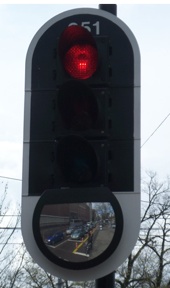
used in Amsterdam to reduce
right-hook collisions.
(Photos: Todd Boulanger)
Here’s an interesting idea that was spotted by City of Vancouver transportation planner Todd Boulanger on a recent trip to Amsterdam.
Boulanger visited the Netherlands in April to attend the Intertraffic Conference and he ran across what he calls a “new application of a traditional tool” — convex mirrors placed on traffic signals. They’re called black spot mirrors or “dead angle mirrors”.
According to Boulanger, the mirror is heated for all-weather use and it can be turned to any angle, independent of the existing traffic signal.
Here’s another photo:
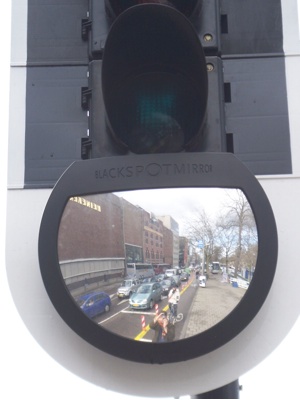
In Amsterdam, traffic engineers and advocates are working together to reduce collisions in the “dead angle” of truck drivers. One reason cited for the success of these mirrors — which have been installed at over 100 locations in Amsterdam — is that they are placed where motorists are already looking (as opposed to just another traffic sign).
Boulanger also passed along this quote from Tjeerd Herrema, Transportation Alderman for the City of Amsterdam:
“There is still too much misfortune because of bicyclists hit in the dead angle of truck drivers. These black spot mirrors improve visibility within the ‘dead angle’. Each movement victims prevented is welcomed. The mirror is one of the resources installed to improve the road safety in Amsterdam.”
It seems an inexpensive solution like this could vastly improve safety at intersections — especially ones like W. Burnside and 14th in Portland, where a woman on a bike was killed back in October.


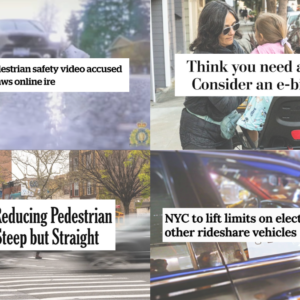
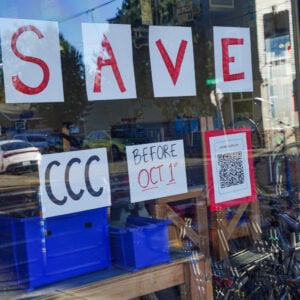
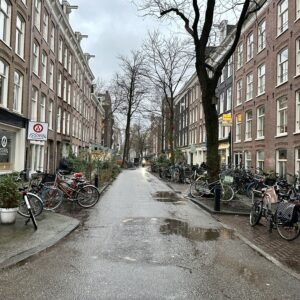
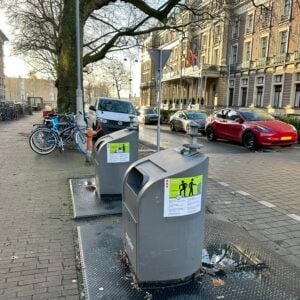
Thanks for reading.
BikePortland has served this community with independent community journalism since 2005. We rely on subscriptions from readers like you to survive. Your financial support is vital in keeping this valuable resource alive and well.
Please subscribe today to strengthen and expand our work.
These would be awesome.
Mr. Geller. Paging Mr. Geller.
Mr. Bricker. Paging for support from Mr. Scott Bricker.
Let\’s all get behind this one, presuming that the federal, state and local traffic guidelines permit us to install them. This one seems like a real no-brainer.
Oh man, what an awesome idea–inexpensive and easy!
I can\’t imagine there would be any guideline that would forbid something like this. We already have mirrors at blind hairpin corners.
Like SW Broadway and Hoffman.
I really don\’t see a downside to mirrors like this.
Traffic signals have a specific set of guidelines as to design and placement. What seems common-sense is not always so, hence my caveat.
I\’m not a traffic engineer, I\’m a traffic engineering hobbyist, and I leave the regulatory compliance up to the pros. 😉
I don\’t see a downside either, but that\’s usually just when government mucks things up.
The one issue with these is, at least at some intersections, the fact that we use suspended traffic signals, rather than post mounted signals. SW 14th and Burnside (where Tracey Sparling was killed) is a great example of this, if I remember correctly.
Just like bike boxes I feel these would have a greater effect when vehicles are stopped. Once vehicles are going most people just take a quick glance at the light and go, rather than looking intently at it.
Despite these criticisms, I believe that they are worth trying at various intersections. You can, almost, never apply too many safety devices/protocols.
Another idea – though it would require more complex infrastructure – could be to provide a \”bike present\” light linked to sensors in the lane (spaced to detect approaching cyclists, not just waiting ones). Not sure if this is a variation or even full description of the \”bicycle signals\” I\’ve seen referred to on this blog. Here in the Beav some newer intersections switch lights when no cars are present, so maybe their sensors are independent of the car loops(?). All of my right hooks have been approaching green lights into cars not signaling; as Russell described the mirror is more a static solution catching stopped riders, and I agree with him that placement is also key.
lets give it a try. do we have the cash?
Having never used one I can\’t vouch for its usefulness, but the mirrors seem a bit small. Seems like it might be tough to pick out a cyclist blending in with the background of pedestrians and buildings. Russell has a good point too, about the suspended traffic signals. When it gets windy they wouldn\’t do any good.
But then again, I can\’t imagine this would be in use anywhere if it weren\’t worthwhile.
There is so much to be learned from the Dutch, we would be foolish not to. Where was this picture taken? Is this in the de pijp outside of the old heineken brewery? I used to live right behind the old brewery. I remember one (sad) day leaving for work and seeing the police and ambulance arrive because a bike had gone under a truck near the traffic circle outside of heineken plein. I stopped and watched for a while, a special investigations truck immediately arrived – they cordoned off the area and they took tons of pictures (it was fatal). Sad as it was you could tell that they took safety very seriously and all serious accidents are thoroughly investigated. Chaotic (or beautifully choreographed) as the streets may seem in Amsterdam I\’ve always felt safe on them over the 2 years I\’ve lived there. It\’s exciting that Portland is now \’Platinum\’ though it is just one stepping stone towards becoming a truly multimodal city.
Technology, even really low tech technology like these mirrors, is not the solution. Motorists have to learn to pay attention. Importing something successful in Europe is, in my opinion, unlikely to work here because of the attitudes of motorists. We need an attitude adjustment. How about some serious laws to protect vulnerable road users and some serious law enforcement? Please!
Ooohhhh… I LIKE IT!!!
Cheap, Simple, and Effective!
Rubberside Down!
K\’Tesh
Why can\’t we retrain motorists AND get these cheap mirrors?
Yep, I knew there\’d be a post (or twelve) like JG\’s. A piece of safety technology that works somewhere other than Portland? Guaranteed, if you suggest using it in Portland, there will be objections. Mirrors? We don\’t need no steenking mirrors. Certainly, let\’s not consider that using devices like this might promote a change in attitude among all road users; they just need to change, that\’s all. Me, I say that none of it is really necessary (if I\’m in Detroit, I\’ll still be riding) but anything that helps, helps (given the choice, I\’d rather be riding in Amsterdam).
J G,
Yes, let\’s seriously enforce the rules of the road. And really we do need an attitude adjustment.
And apply these to cyclists as well. Rolling stop signs is illegal whether you like the law or not. Failing to signal turns is illegal.
If we as cyclist do not abide by the laws that are in place, then we cannot expect drivers to do the same.
Reply to \’n8m\’.
Yes this location where I took the photos is near the old brewery. (It is now a museum and a place to sample a brew – I have read.)
And for another post – I think I have heard that the W. Burnside intersection at 14th (?) has older signal controllers (timed) so it is on a clock…vs. loop detection. This is very common in downtowns vs. in the suburbs.
The other design issue…in the States that would have to be addressed for using such mirrors would be the placement of the traffic signals…most of the \’modern\’ intersections place the signal at the far side of the intersection…vs. what is done in Europe and some older US cities. Many older US cities have signals still placed on poles vs. arms (Seattle, DC, NYC, Honolulu, etc.).
[I have not yet found a good historical or safety reason why the US practice has evolved differently from Europe on the placement of signal heads (far vs. near side). The European practice would keep more cars from encroaching into crosswalks and bike boxes…though it would also reduce the storage capacity of the intersections for cars (important for short Portland blocks)…though this seems to be of a secondary importance than traffic safety for vulnerable raod users. Any traffic engineers out there know the real historical answer to this?]
Also…the company that makes the BSM replied to my email asking for information…it came in today\’s mail.
[They also make most if not all of the small bike traffic signals used in Amsterdam.]
—————-
Dear Mr. Todd Boulanger
With reference to your e-mail of 21 of April.
I am sorry for a late reaction.
The “Blackspotmirror” is design for 2 years ago, after some test, with 3 peaces, in the site of Amsterdam, the city road authority decayed to place them on 100 places in town, with a dangerous right hook. Where the combination bikes and trucks.
The combination traffic light and mirror in one house will be the key for his success.
When the truck driver is waiting for his green light he or se can also see what is happening on the right and in the front of the truck.
For proper use the mirror is also heated in seat, for ant condense on the mirror.
The product will be coming more and more in use, mostly after an terrible accident with a biker.
You can find the in some big cities in the Netherlands, Amsterdam, Rotterdam, The Hague, Weert and Alkmaar. In Belgium the road authority of Antwerp is very interesting for this system.
The product traffic light (depends on the light bulp/system) and “Blackspot mirror” cost about (in euro) € 2.000 (TB: US$3000+) without pole and installation cost, ex works.
Enclosed in this e-mail you find a leaflet from our product, sorry written in Dutch)
Kind regads,
Leon Rutten
Groenpol Verkeerssignalering
onderdeel van Ko Hartog Verkeerstechniek B.V.
Marconistraat 35 lrutten@groenpol.nl
1704 RH Heerhugowaard http://www.groenpol.nl
T +31(0)72 5350540, T direct +31(0)72 5672024
F +31(0)72 5350549
M Mobiel +31(0)6 53387646
Todd,
I have heard that Europe uses the near-side signal placement so that traffic on the cross-street cannot view them, a practice which we in the US use to \”cheat\”, and start moving just before the green. Of course, their placement makes drivers waiting at the stop bar look straight up for the signal, which is not particularly comfortable.
Several states augment the farside signals with a nearside signal on a pedestal pole, so that small vehicles stuck behind large ones still have a visible signal.
Since drivers are generally going to be focused on the farside signals, even if we installed a nearside signal, there is an additional issue to resolve here. It\’s certainly worth exploring further.
I obey traffic rules to the best of my ability while on my bike for the same reason many cyclists choose to voluntarily don head-gear. Which is one of public perception, and promoting as positive an image of the mode as I possibly can. But this one, just this one thing, twists parts of my anatomy until I\’m screaming every time.
This is a fairly new thing. Oregon Revised Statute 814.440, that is. USED to be, hand signals were prohibited any time forward facing lights were required by law. No-brainer IMO, because of the fact that hand-signaling is all but useless at night. Clearly, this prohibition was intended to make it illegal to operate an on/off road (Enduro) motorcycle after dark, that wasn\’t usually manufacturer equipped with turn signals. But this prohibition also applied to bicycles, and caused no end of grief for all involved. The SOP at the time was for enforcement to simply turn-the-other-way where bicycles were concerned, unless of course you looked like the type to be carrying your stash with ya!
So, the solution, the right solution, was to exempt bicycle riders from this statute. At some point, I haven\’t researched it fully yet, the old Statutes were scrapped and replaced with 814.440. Which of course mandates the use of hand-signals by bicyclists. There is a provision for using one\’s own judgment for safety\’s sake, but again, these sorts of provisions are rarely provable in court; and are just as hard to prove as, \”I was not riding as far right as possible in my lane, your Honor, because there was potentially hazardous detritus present\”. You\’ll find if you deploy this defense that the spirit of the provision is intended to pertain to tree-limbs, animal-carcasses, and other OBSTACLES, and not just to avoid a flat. Kinda sucks, but true.
One is prohibited, still, from using hand-signals in a car at night; why then are cyclists required to use them at night? If you agree that they aren\’t effective at night, when it\’s arguably more dangerous on the road for every one, then how can one sustain the argument they are useful for cyclists during the day? The notion of being required by law to use hand-signals on my bicycle is the same as requiring me to do so while on foot. Or, utterly ridiculous if you prefer. About as nonsensical as requiring me, by law, to wear a styrofoam-cup on my head.
I use hand signals when I feel compelled to signal to people around me, my intentions. I use my own personal judgment, which is clearly against the one law I\’m inclined to ignore. Which isn\’t to say I\’m anti-helmet, or hand signaling. I\’m just saying I\’d prefer to save the money spent on the law, in lieu of allowing folks to use their own judgment, is all.
Now, I wrote this novella for purposes of gauging BikePortland.org-folks and their opinions regarding hand signals. They are, as this other commenter pointed out, required by law. I think they are more dangerous and unsafe, than the situations mandating their use is intended to prevent. Likewise, there is absolutely nothing in statute exempting us from using them at night. These are laws that are there for no other purpose than for law-enforcement to use them as probable cause, and harass people Police Officers feel personally compelled to harass.
Oh, and the mirror thingy\’s don\’t look all that effective, but if the communal position is one of, \”Let\’s give it a try\”, then by all means, let\’s take a look at these things. Har. Sorry to be off-topic.
I think the convex mirror is a cool idea, low tech, and definitely workable. I think it might require a bit of education, and possibly some changes to the driver\’s license laws. Now why would I say that? Because new laws are less than useless if nobody knows about them, and the only way to make sure people know about the changes is to test then on it. Current laws pretty much declare that if you pass the written once in your life you\’re good forever. Pilots know better, they are required to take the equivalent of the driving test every 2 years and have a little oral exam about the changes in flight regs before the flight. It\’s called a biennial review, and every pilot is required by law to pass it before flying again. That\’s every pilot including the guy with the little plane that only flies 2 or 3 times a year when the weather is good… We need the same thing for drivers.
Now as for hand signals, I use them, even though people have mistaken them for waving or making an obscene gesture. I used to have reflective bands that i would wear on my wrists so my signals could be seen at night but I lost one, and it never seemed to make any difference one way or another.
I\’ll respond in reverse order,
Opus – I\’m all about motorists needing to retake the drivers test every few years, especially as one ages. Maybe every 4 – 5 years for the written and every 6-10 years for a driven exam. Maybe base it off of traffic violations received (i.e. someone who gets pulled over a lot has to do the exam earlier)
Vance – great discussion about hand signals. I use them and I don\’t. I do not really think that people need to know I\’m turning right unless I\’m drastically slowing down (same with left from a one-way street). I do, however, use them when I\’m turning left from a two-way street or when I\’m merging lanes. For the latter I find them the most important; when I go to change lanes I find that people do not continue to accelerate into my and give me room to merge if I signal beforehand, while if I simply look over my shoulder and move over a lot of motorists still run up on my wheel and tailgate. There are few roads that it is incredibly difficult to signal on if you\’re moving, such as the intersection of 23rd and Everett – the road is just far too rough. So, in summary, I believe hand signals are a great thing to do when it makes sense to do so. Do not put yourself into danger trying to use them, but they can also help alleviate danger in some other situations.
Now back to these mirrors – I think that re-educating drivers is very important. I think that re-engineering our roadways and employing new technologies is very important. This is a great and simple technology to try at various intersections where they work. The problem is that, with our far-side, hanging traffic signals, there is not an opportunity for large scale deployment without reworking how we mount our traffic signals.
Hey that\’s a really good point about licensing #19. That\’s a take on a position I already agree with, that I had not really heard before. I would caution you regarding one thing though. Attempts to make motor-vehicle licensing requirements more stringent have historically resulted in lowering pass-rates among women and minorities. No kidding. So they\’ve been successfully defeated on this point alone. The solution, it would seem, would be educational outreach, but then you have a sitch\’ where specific groups are targeted for benefits the rest of the group are not, and again another legitimate gripe.
I for one oppose bicycle-specific licensing, or the addition of an endorsement to an existing Driver License, like for motorcycles. But I do feel that one should possess the knowledge of the rules that one typically has after obtaining a license in order to safely access the public right-of-way. That should read: I feel you should have a valid License to ride on the road. This would ban people under 16 though, and opens a can of worms regarding disciplinary Driver License suspensions. Often, suspended drivers turn to the bicycle while suspended, and wouldn\’t have that option.
Sooner or later we\’re going to have to bite the bullet on licensing. Something\’s gotta give. This written test a couple of times in your life thing is just not practical in today\’s America.
I read up on the mirrors, and am very interested now. At first glance, I made the assumption they were for viewing traffic moving perpendicular to the user. Instead, they are intended for large vehicles to use for viewing the areas beside their vehicles. The dreaded blind spot. I hope they give these a try. Much easier sell to big oil as it let\’s the private-sector off the hook regarding more equipment mandates.
I need to take a writing class and learn a little about brevity, methinks.
Thanks #20. I appreciate your examples. My brother received a life-threatening sub-dural hemotoma (While wearing a helmet.) in a crash resulting from taking his hand off the bars, at just the right moment, to hand-signal. He almost died, and injuries of that sort can often have behavioral ramifications later in life. Hand signaling is a useful tool for cyclists, but should not be mandated by law, in my opinion of course.
The absolute stupidest hand signal requirement has got to be the one that requires a cyclist to continuously signal a stop 100 feet before the stop.
Practically speaking, in a city with 200\’ blocks, nd stop signs on every corner, that means you\’re required to ride for 100\’, then signal for 100\”, all the while trying to stop your bike using a handbrake but without using your hand. Then, you proceed for another 100\’, before signaling your intention to stop for the next 100\’.
Repeat every block.
Obviously not a law drafted with any input from people who have actually been on a bike post-childhood.
another band-aide solution to a problem that won\’t be completely solved until destinational positioning is fully accounted for in the design of bicycle facilities.
Good idea. But, OR statutes says bicycle driver still has the obligation to avoid blind spots and prevent problems. Get in FRONT of trucks.
#25 – Please cite that statute. I am looking at all the statutes surrounding both motor vehicles and bicycles and see no reference placing any obligation upon people to \”avoid blind spots and prevent problems.\”
#26, O.S. 811.005–Duty to exercise due care. Also, refer to various Oregon case law. Courts have generally held that all drivers of vehicles are obligated to be mindful of the safety of all other roadway users.
Bicyclists, as drivers of vehicles, are therefore obligated to not only encourage motorists to obey the law, i.e. taking the lane, and prevent problems for themselves, but also to make sure motorists see them.
There is a legal concept called \”foreseeable danger.\” A homeowner who doesn\’t clear ice from his property can lose a lawsuit to injured parties who fall and slip on his property.
The syllogism goes something like this: The truck\’s blind spot is a \”foreseeable danger.\” Other roadway users assume some risk if they are in the blind spot. This is a very common tactic for defendant to reduce awards to plaintiff.
I don\’t have Westlaw anymore. But, case law puts meat on the statutes.
Mirrors look like inexpensive improvement upon safety. I can\’t think of a downside.
While off topic from original post, it\’s a worthy discussion…
Regarding hand signals, I usually do use them for turns but not for braking. If I need to be on the brakes as in a hill followed by a corner I skip the signal because I\’m kinda busy piloting the machine to screw around with signals.
And the style of signal I use is to is a quick point left & point right. I believe that the left arm up salute to signal a right turn is less clear for drivers.
On a related note, in terms of rules of the road, I choose safety over what is legal every time. Usually what is legal is also safe but there are plenty of instances where the lowest risk involves some rule bending. I am always cognizant of how my actions are perceived by motorists and that weighs into the decisions.
Regarding BikeBillboards\’ post #27:
I\’m usually pretty quick to criticize Paul Tay\’s posts (BikeBillboards) when I think he\’s wrong, so let me be equally quick to point out this time that he is absolutely correct, and I daresay that Mark Ginsberg, Ray Thomas and a.O would likely agree with his interpretation.
The legal requirement for \”Due Care\” is the underlying fabric of all of traffic law. We have a responsibility beyond merely following the laws, we have a responsibility to anticipate certain situations before they occur and take reasonable steps to prevent those situations from unfolding in a way that could harm ourselves or others.
The tricky part is figuring out exactly what constitutes \”reasonable\”, and that\’s really up to the judge.
#29, in a trial court, \”reasonable\” is an issue of fact. If you, the bicyclist, is the defendant, either the judge or jury will decide \”reasonable.\” The problem? The judge and jury DON\’T bike.
If you appeal, you can\’t challenge findings of fact. If the judge or jury says what you did on a bike is not reasonable, it\’s not reasonable. DONE. Game OVER. You can only challenge issues of law.
The problem with the criminal IN-justice system as it relates to bicycles is the failing of the driver\’s ed system that ignores bicycle issues. You guys need to start pushing for bike driver ed in high school at the state level.
Well, that\’s sort of true, but you should really read Previs v. Dailey, where an appellate court threw out a jury\’s verdict against a cyclist because the verdict was so overwhelmingly against the evidence that it could only have been due to prejudice.
State should have appealled in State v. O.J. Simpson.
BTW, Matt, #29, the reason why you disagree with me on some issues is because you are misguided and afflicted with Forester\’s cycling inferiority complex on those issues.
Bike Billboards drivers have to be right,
EVERY trip. We roll ANYWHERE, anytime. Our clients typically want eyeballs on their billboards. That means rush hour traffic on roadways with LOS D, minimum.
If we are less than 100% RIGHT, every time, day-in, day-out, TFD and EMSA would have scrapped a contrail of intestines and colon two miles long off the Broken Arrow Expressway a long long time ago.
Gentlemen…All it takes is a VC discussion to grind on and scare away readers … to ruin any BikePortland blog discussion…
During my recent trip to London UK – the city of London announced at the UK Bike Show that it too will be deploying these mirrors at blackspots where truck drivers tend to run over bicyclists.
Here is an auxiliary mirror that a truck operator (or fleet manager) can install to affordably reduce their blind spots and enhance their field of vision of cyclists when turning right.
https://www.youtube.com/watch?v=Gf6naIqVTgs